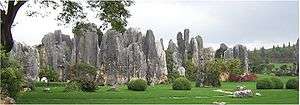South China Karst
| South China Karst (Phase II) | |
|---|---|
| Name as inscribed on the World Heritage List | |
|
| |
| Type | Natural |
| Criteria | vii, viii |
| Reference | 1248 |
| UNESCO region | Asia-Pacific |
| Inscription history | |
| Inscription | 2007 (31st Session) |
| Extensions | 2014 |
The South China Karst (simplified Chinese: 中国南方喀斯特; traditional Chinese: 中國南方喀斯特; pinyin: Zhōngguó Nánfāng Kāsītè), a UNESCO World Heritage Site since June 2007,[1] spans the provinces of Guangxi, Guizhou, and Yunnan. It is noted for its karst features and landscapes as well as rich biodiversity. The site comprises three clusters: Libo Karst, Shilin Karst and Wulong Karst. UNESCO describes the South China Karst as "unrivalled in terms of the diversity of its karst features and landscapes."[1]
South China Karst - UNESCO inscription details
| UNESCO Inscription No | Name |
|---|---|
| 1248-001 | Shilin Karst - Naigu Stone Forest (乃古石林) |
| 1248-002 | Shilin Karst – Suogeyi Village (所各邑村) Shilin Yi Autonomous County |
| 1248-003 | Libo Karst – Xiaoqijong (小七孔) Libo County |
| 1248-004 | Libo Karst – Dongduo (洞多) Libo County |
| 1248-005 | Wulong Karst – Qingkou Giant Doline (Tiankeng) (箐口天坑) |
| 1248-006 | Wulong Karst – Three Natural Bridges Wulong County |
| 1248-007 | Wulong Karst – Furong Cave Wulong County |
Gallery
| Wikimedia Commons has media related to South China Karst. |
 The Shilin (Stone Forest) South China Karst formations scenery
The Shilin (Stone Forest) South China Karst formations scenery- Karst limestone stalactites in the Furong Cave.
- Tianlong Bridge, a South China Karst natural arch.
References
- 1 2 "Twenty-two new sites inscribed on UNESCO's World Heritage List, and one deleted during Committee meeting in Christchurch". UNESCO World Heritage Convention. 29 June 2007. Retrieved 2011-02-14.
External links
This article is issued from Wikipedia - version of the 10/12/2015. The text is available under the Creative Commons Attribution/Share Alike but additional terms may apply for the media files.
